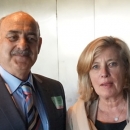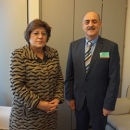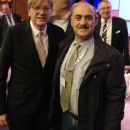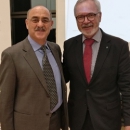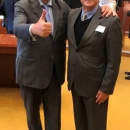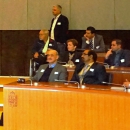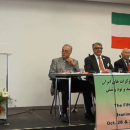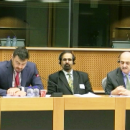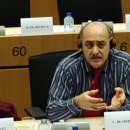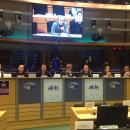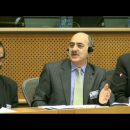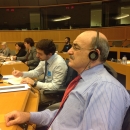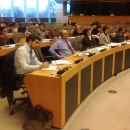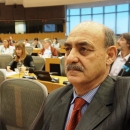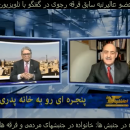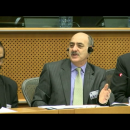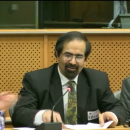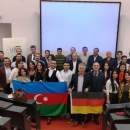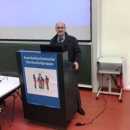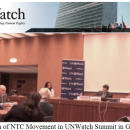Darin J. Challacombe
Abstract
Previous research has shown that religious organizations are more similar to terror or violent extremist organizations than they are dissimilar (Banisadr, 2009; Centner, 2003; Levine, 1999). Individuals who join both usually have similar characteristics. Because
contemporary researchers have focused more on terror groups than on cults, the archival knowledge from cult survivors and years of cult research has not been adequately illuminated as a guide for terror studies. The current literature review attempts to remedy this gap. Using the PRISMA methodology (Moher et al., 2009), I examine the literature
of religious-cult recruitment, terror-organization recruitment, and radicalization, to illuminate the multiple confluences between them. Just as cults and terror organizations are similar in many other aspects, they also tend to follow similar recruitment patterns. Understanding cult recruitment can be useful to terror researchers.
1 Author note: I have no known conflict of interest to disclose. Correspondence concerning this article should be addressed to Darin J. Challac ombe, Department of Psychology, Fort Hays State University, 600 Park St., Hays, KS 67601. Phone: 785-628-4405. Email: djchallacombe@fhsu.edu
An Indian Bhagwan (guru), Shree Rajneesh, started a collective in the 1960s (Carus, 2000). He was known as an intelligent, “enlightened master” who was adept at manipulating people. Rajneesh and his followers immigrated to the United States in 1981 after facing growing pressure and hostility from the Indian government. The Rajneeshees,
as they were called, settled on a plot of land mostly located in Wasco County, Oregon.
The Rajneeshees envisioned creating a self-contained town in Oregon, which was named Rahneeshpuram. The relationship between the community and the Wasco County commission became contentious, and in early 1984, the Rajneeshees desired to take over the commission. They internally proposed several schemes but eventually settled on using biological agents to make Wasco County citizens sick, to prevent them from voting in the November election. Rajneeshee cult members contaminated salad bars of Dalles, Oregon restaurants that were then in the county seat with the Salmonella Typhimurium pathogen. From the first reported illness on September 17, 1984, until the end of the salmonellosis outbreaks a couple months later, public health officials identified 751 people who had become sick.
The Rajneeshee incident is the single largest bioterrorism attack on US soil (Novak, 2016). Around the same time in 1984, and halfway around the world in Beirut, Lebanon, a suicide bomber killed 23 people and injured approximately 60 others in a terror attack. Hezbollah, a Shia Islamic terror organization with connections to Iran, claimed responsibility for this attack. The suicide bomber drove a van with 3,000 pounds of
explosives to the front of the US Embassy annex in Beirut (Kraus, 2013). This attack followed a deadlier one in Beirut in April of 1983, in which 63 people were killed and 120 were injured. Both attacks underscore how a militant Islamic organization caused terror (Kraus, 2013).
Just a few years earlier, in November of 1978, a religious group, the People’s Temple, evolved into a cult that followed leader Jim Jones (Challacombe, 2004). This cult committed an act of domestic terrorismin a remote region in Guyana, South America—not only killing each other but also US Congressman Leo Ryan (Lalich, 2009).
Do these three separate incidents demonstrate a synergy between a strictly religious cults, or strictly terrorist organizations? For the ajneeshees, Hezbollah, and People’s Temple, was the designation of religious cult or terror organization mutually exclusive? Previous
research has elucidated that both religious cults and terror organizations typically have strong, controlling leaders. They both have membership-vetting and -pruning processes. Both have grievance narratives and end-state goals. And both believe in or follow
processes that differ from the status quo.
This present systematic review aims to examine the separate bodies of research of both religious cults and terror organizations, specifically in regard to their recruitment strategies. I have chosen recruitment strategies to help address the intelligence gaps that exist on this topic in the terrorism space; this focus allows for a further examination of
the similarities between cults and terrorist groups.
Method
I completed a literature search of research that discussed recruitmentprocesses of religious cults and terror organizations. I carried out the search using the guidelines of the Preferred Reporting Items for Systematic Reviews and Meta-Analyses (PRISMA) checklist (Moher et al., 2009). I chose to use the PRISMA because of its practical nature for
systematic reviews and my familiarity with it from previous research.
I searched the following databases: a) Web of Science, b) PsychInfo, c) EDLINE, d) National Association of Social Services Workers [NASW] abstract database, and e) Homeland Security Digital Library. In addition, I conducted searches through special reserves of the International Cultic Studies Association (ICSA) and the Federal Bureau
of Investigation (FBI). I used the inclusive search terms recruit*, cult*, and terror*,
specifically looking at articles published after 1960. Then I critically examined the results. I documented, summarized, and grouped substantive, relevant articles together in a narrative fashion in the following content.
Cults and Cult Recruitment
Cults are “high-demand group[s]” (Langone, 2019a, p. 6) that are best thought of as being on a continuum in contrast to a cult/noncult threshold (Whitney, 2016). Deception, manipulation, and potential harm are close to the cult end of this continuum. Other factors, such as strong, assertive leaders, are somewhere in the middle of the
continuum and often are parallel to mainstream religious organizations.
Many people incorrectly associate cults with or believe that they all end like Jonestown or Heaven’s Gate. However, cults do not always end with members committing suicide or other violence (Lalich, 2009; Langone, 2019a). Cult members do often experience psychological trauma as a result of their involvement. Although that trauma may be
triggered by a variety of causes, cults lack accountability mechanisms to handle or respond to the harm they cause (Langone, 2001). Cults often also create economic, physical, or spiritual harm against their members.
Researchers have explored generalized recruitment strategies used by religious cults. For example, Wexler (2016) summarized cult recruitment as reducing “the critics’ interference by culling the target sample into pools” (p. 37). Cults often employ overt deception to
prevent potential recruits from knowing the true nature of the organization (Langone, 2001; Wexler, 2016). Such groups may use imagery or public discourses to communicate with unsuspecting individuals (Miyamoto, 2014). These groups may even “love-bomb”
potential targets—t individuals are showered with affection and attention in order to gain compliance (Davis, 2018, para. 5). Zimbardo and Hartley (1985) also suggested that predispositions or precontact variables (e.g., gender, race) may set a stage for recruiters.
Individuals targeted for recruitment also vary. Cults often target people who are stressed or vulnerable in other ways for recruitment (Curtis & Curtis, 1993; Davis, 2018; Levine, 1999; Schwartz, 2001).
Recruiters may target senior adults or those with limited support structures, especially those who are looking for ways to do good for others (Schwartz, 2001). Groups frequently target youth, often considered more susceptible to manipulation (Levine, 1999; Miyamoto, 2014). As an example, Zimbardo and Hartley (1985) found that a surprising number of high-school-aged participants already had previous contact with cult members or were receptive to attending a cult function if they were invited. These participants were not
uninformed or gullible students; rather, the researchers found them to have average grades, lots of media exposure, and moderate engagement in religious practices. The participants were described as being “contact-prone” or “affiliation prone” versus individuals who were perceived either to have sought out or had been manipulated into joining cults (Zimbardo & Hartley, 1985).
Stein (2017a, 2017b), Collins (1982), and many others have suggested “brainwashing” as a component in the recruitment process. Certainly cults have demonstrated their remarkable ability to rapidly engage with the disenfranchised, including in the People’s Temple and the Branch Davidians (Challacombe, 2004). Richardson (1993) argued that cults do not brainwash people, but rather they facilitate individuals who are already seeking out something new. Levine and Russo (1987) found that new group members often have the tendency to variably influence the majority group members; this finding
suggests that recruits could potentially mitigate a cult’s brainwashing techniques. Overall, research would suggest that groups do influence people to a great extent, regardless of whether this influence is considered “brainwashing.” Stein (2017a) also proposed that cult recruitment sometimes involves isolation. Isolation is a reoccurring theme among researchers (Davis,
2018; Kent, 2008). Isolation occurs when new recruits are strongly
encouraged or forced to ignore their established support structure or
former lifestyle. Research has shown that isolation is often easier for
potential recruits since many already had loose or weak ties to friends
or family (Richardson, 1993). And instead of physical isolation, the
isolation also may be in the form of censured news or materials
(Davis, 2018). The isolation in a cultic environment facilitates and
expedites the process of engraining a grievance narrative or belief
system into the recruit (Kent, 2008; Richardson, 1993; Stein, 2017a).
Although individuals may be more susceptible to joining a cult,
researchers have shown individuals will usually be interested before
they are actively pursued (Stein, 2017a; Zimbardo & Hartley, 1985). If
individuals show signs of interest, recruiters will then engage with
them in a way that shows them increased attention (Davis, 2018;
Richardson, 19930. Once recruits indicate they are truly interested in
joining, the group then will attempt to isolate and them in order to
eventually get them to recruit others as well (Miyamoto, 2014;
Wexler, 2016). It is this process that appears to parallel the
recruitment process of other groups such as gangs, political or racist
groups, and terror organizations (Schwartz, 2001).
Terror-Organization Recruitment
Terrorism has become more ubiquitous over time and in recent years
has impacted many areas of society, including business, research,
government, and education (Silber & Bhatt, 2007). Terrorism has
many definitions, ranging from explicit to vague and general. One
more explicit definition considers terrorism “an act of violence
(domestic or international), usually committed against
noncombatants, and aimed to achieve behavioral change and political
objectives by creating fear in a larger population” (Doosje et al., 2016,
p. 79). A broader definition summarizes terrorism as the
“communication of a message to a target audience” (Mahmood &
Jetter, 2020, p. 128). Both definitions generalize terrorism acts as
purposed to communicate a message or change behavior or politics.
Over the past two decades terrorism has transformed from
established, coordinated groups to small cells or even lone actors. In
this space, lone actors are usually individuals intent on committing
acts of terrorism, whereas a terror organization could be anything
from a loose affiliation of individuals to structured, state-sponsored
groups (Gill, 2016).
We are seeing an increase in homegrown terror, wherein individuals
are being encouraged to act on their own (Bouhana et al., 2018; FBI,
n.d.; Gill, 2016; Sarat-St. Peter, 2017). With this change, terrorism
recruitment and radicalization are frequently and incorrectly seen as
similar processes (Jones, 2017). For example, analogous to
recruitment into cultic activities, recruitment is the movement of an
individual to become part of a group, whereas radicalization is
considered the process in which an individual exhibits more interest
in an idea, theory, or belief that the group stands for (Karakatsanis &
Herzog, 2016). Radicalization is also used to describe political
activities. The negative connotation to the term is based upon the
viewer’s perspective—adoption of Marxist ideals may be positive or
negative radicalization (Karakatsanis & Herzog, 2016). Kajsiu (2016)
elaborated on this point by showcasing Albanian evolution in its
democratic process. Over several years, Albanians exhibited
substantial shifts toward the European Union and pro-democracy
practices.
Recruitment is a process in which an individual is typically
encouraged to join a group (Jones, 2017). The recruitment process
often involves an exploitation and exaggeration of personal issues or
grievances, and the offer of an identity or sense of belonging
(Choudhury, 2007). Typically, recruitment involves a combination of
factors meant to both push and pull an individual toward the group.
Jones (2017) described the push as being the sense of injustice, and he
described the pull as being the sense of belonging. Together, these
factors create a narrative or message a potential recruit can get
behind. Recruitment also is facilitated by communications technology
such as websites and social media (Mahmood & Jetter, 2020). As an
example, some ISIS recruits had found camaraderie and connection
through online chat rooms and Twitter (Juergensmeyer, 2018).
Recently, the QAnon phenomena has further illustrated the power of
social media as a recruitment tool (Langone, 2021). Langone’s
research on this group demonstrates social media’s power to capture
attention and catalyze recruits. One tweet can influence thousands
without the infrastructure or logistics previously required by
recruiters. Social media serves to assist potential recruits in becoming
believers. As Langone (2021) has pointed out so succinctly, QAnon
“may be construed as a safe space for paranoid speculation” (p. 12).
Because the ideals of terrorism are often just a mindset (e.g., a
grievance against a certain person, organization, country, or religion),
radicalization does not necessarily require an individual to join a
group to commit an act of terrorism or be considered a terrorist.
Radicalization can be just the process of an individual deciding to
move toward terrorist ideals (Young et al., 2015). This distinction
differs from political radicalization in motivations, ideology, and
causality.
The motivations for terrorist radicalization typically have a
perspective of victimization that turns into a personal grievance
(Young et al., 2015). Stern (2004) outlined a reoccurring thread in
terrorism grievance narratives: humiliation. Following the American
invasion of Iraq, Al-Qaida used that war as a recruitment tool (Stern,
2004). The Americans were humiliating Muslims and Islamic ideals.
Other grievances include those that encourage immediate action. For
example, Juergensmeyer (2018) identified that many in ISIS
leadership believe the Islamic savior, or Mahdi, will be coming soon;
hence, they must act to establish a Caliphate.
Terrorism ideology differs because it reflects extreme political or
religious views (Chin et al., 2016). For instance, instead of believing
abortion is wrong, a radicalized individual may believe the only way to
stop abortion would be to kill abortion doctors. Organizational leaders
often take advantage of zealous recruits (Stern, 2004). Juergensmeyer
(2018) also has pointed out that some Islamic State of Iraq and Syria
(ISIS) recruits were not idealists or true believers, but rather
individuals looking for an opportunity.
Researchers have created several theories about the radicalization
process to explain terrorist or violent extremist behavior. Historically,
radicalization methods involved stepwise processes that are like
staircases (Moghaddam, 2005), or mechanisms across levels
(McCauley & Moskalenko, 2008). Silber and Bhatt (2007) viewed
radicalization as a four-phase process: Pre-radicalization, Self-
identification, Indoctrination, and Jihadization. In contrast, in
Challacombe’s (2019) domestic-terrorism radicalization model, the
radicalization process is cyclic: Individuals move through several
stages but fluctuate between stronger or weaker attractions in their
shift toward radicalization.
Many people have argued that potential terrorists are just vulnerable
people, but the research is mixed. Gill’s (2016) review of lone-actor
terrorists did not find a definitive pattern of vulnerability (or any
other characteristic) among the actors. Horgan (2014), however,
noted the potential, especially for terrorists who come from
impoverish conditions (e.g., Pakistan, Somalia), that an escape from
the poverty may be a contributing factor. And other researchers,
including Weenink (2015), have found vulnerability to be a
commonplace characteristic in terror groups. Borum (2011a, 2011b,
2004) identified common vulnerabilities seen among extremists as a
need for personal meaning/identity; a need for belonging; and a
perceived injustice or humiliation.
Recruitment and radicalization are related processes by which an
individual might join a terrorist group or act upon a terrorism mindset
(Doosje et al., 2016; Lygre et al., 2011). Both developments often can
advance with the assistance of multiple, disparate influences that can
serve either as inhibitors or catalysts (Challacombe, 2019: Choudhury,
2007; Jones, 2017). The process may target vulnerable individuals
(Bhui et al., 2012; Borum, 2011a; Weenink, 2015) who suffer from
structural unemployment and insecurity (Neumann, 2009),
depression and suicidal thoughts (Horgan, 2014), and other
psychological conditions (Gill, 2016). There are, however, limited
patterns or characteristics that cut across all terror groups or
mindsets.
Recruitment Similarities Between Cults and Terror
Organizations
Religious cults and terror organizations are related, and sometimes
they are identical. Some cults have committed actions considered
terroristic, as with the Rajneeshee cult. Similarly, Aum Shinrikyo was
initially considered just a Japan-based religious cult until its members
conducted several sarin gas attacks 1995 (Raevskiy, 2014). These
attacks, including the large-scale attack on the Tokyo subway, moved
the organization from being perceived as a cult to being a terror
organization. Another example of a cult that turned into a terror
organization was the People’s Temple, where Jonestown members
attacked US Representative Leo Ryan and his entourage in Guyana
before cult members committed suicide (Lalich, 2009). Paramount to
this comparison is the reality that most terrorist organizations have
religious foundations (Conway, 2015). Additionally, religiously based
terrorism can be more powerful than other types as a result of the
intent and purpose of the group (Morehead, 2002).
Stein (2017a) and others have shown how the process of cult
recruitments leading to new recruits’ disengagement with their
former lives parallels similar experiences of new recruits to terror
organizations. Stein (2017) described this as a
three-fold process in setting the stage for the creation of a
disorganized attachment bond to the group: the initial contact
and gaining access to the recruit, positioning the group as a
new perceived safe haven, and beginning to detach the recruit
from prior attachments. (p. 43)
Similarly, Young (2012) generalized cult recruitment as being a core
component to cult membership, which appears to mirror the
recruitment and radicalization process of terrorists (see Horgan et al.,
2016; Mullins, 2009; Schwartz, 2001).
Numerous qualitative sources support Stein’s (2017) similar depiction
of the process of cult and terror-organization recruitment. For
example, a former member of the Islamic Marxist organization
Mujahedin-e-Khalq (MEK) described how he was separated from
family, subjected to mind manipulation, and forced to see things as
black and white (Forrest, 2014). Other researchers have noted how
both types of groups will lie to potential recruits and utilize coercive
persuasion techniques (Rodriguez-Carballeira et al., 2010).
Others, however, have argued that recruit for cult and terror
organizations differs. Mansfield (2002) suggested that a terrorist
recruit willing to go off to be trained was different than a cult recruit
who just happened to commit an act of violence after being trained.
Deception in terror organizations may involve the end result, or
intended outcome of the training, such as the 9/11 hijackers actually
being on a suicide mission. Sageman (2008) also echoed these same
sentiments, instead proposing that most Islamic terror recruits self-
select and willingly join terror organizations. Their motivation often is
fame and thrills, coupled with a desire to create an Islamic utopia.
These researchers were unable to suggest that isolation is not a factor
in keeping a recruit.
Much earlier, Zimbardo and Hartley (1985) examined the Contract-
Indoctrination-Conversion model for their study. This model has four
distinct phases: Precontact, Contact, Mediational Process, and Outcome.
Each phase includes several subelements (e.g., for Contact Variables,
there are both Strategies and Tactics). The model is linear—an
individual begins at one end and then progresses through the stages
until the end. Recruitment, according to this model, begins with an
individual having either fixed (viz., age, sex, class) or modifiable (e.g.,
media practices, times moved, shyness) predispositions and a
knowledge structure. Then a recruiter gets involved using strategies
and tactics.
Another recruitment model, Silber and Bhatt’s (2007) terrorism
radicalization model, mirrors the Zimbardo and Hartley (1985) model.
Silber and Bhatt (2007) described their pre-radicalization period as a
time before an individual (in this case) becomes knowledgeable about
Salafi Islam. The individual then becomes involved (self-identification)
as the result of catalysts such as a crisis (losing a job, death of a close
family member, etc.).
Silber and Bhatt (2007) described some indicators of individuals
adopting Salafism as a) becoming alienated from one’s former life; b)
joining or forming a group of like-minded individuals; c) giving up
cigarettes, drinking, gambling, and urban hip-hop gangster clothes; d)
wearing traditional Islamic clothing and growing a beard; and e)
becoming involved in social activism and community issues (p. 31).
These traits parallel Diane Benscoter’s (2013) and many other’s
experiences in joining cults. With the Church of Unification, Benscoter
described a similar movement. As a result of her trip to Des Moines to
see Moon, she described a progression of having to adhere to the
Unification Church’s rules regarding dress, dating, and so on. This
movement also tracks with Zimbardo and Hartley’s (1985) model
during their Contact Variables stage: The purposes of the persuasion
in these instances were geared to change attitudes, modify behaviors,
alter knowledge, and the like.
In the Silber and Bhatt (2007) Indoctrination phase, the individual
accepts the religious-political worldview of the Islamic religion. The
main indicators are the withdrawal from the mosque and
politicization of new beliefs. Techniques such as isolation are used in
both terror organizations and cults to place the recruit in an increased
vulnerable state (Rodriguez-Carballeira et al., 2010). Banisadr (2009)
also identified isolation as the key to changing an organization—
religious or otherwise—into a cult. And the Al-Qaida recruit manual
specifically states to isolate a new recruit to “create a more favorable
environment” (Noah, 2009, para. 6). In Zimbardo and Hartley’s (1985)
model, the individual acquiesced, complied, and affiliated with the
cult. Benscoter (2013) also described this as she progressed through
the ranks of the Unification Church. More recently, Charlene Edge
described in detail her meteoric rise through the ranks of The Way,
eventually becoming one of the most trusted members (Edge, 2017).
Stahelski (2005) proposed that terrorists and cults are very similar.
The process Stahelski described the process for both using a five-
phase conditioning model: a) Depluralization; b) Self-individuation; c)
Other-deindividuation; d) Dehumanization; and e) Demonization. This
social-psychological conditioning process mirrors both the Zimbardo
and Hartley and the Silber and Bhatt models. Individuals progress
through various stages that build upon each other. Eventually, the
individuals get to a point of demonization—either believing others
outside the cult are bad or believing others outside the terror
organization should be targeted. The pathways and conclusions are
similar enough to draw parallels between the two groupings.
One of the more inclusive models that incorporates aspects of others
is Langone’s (2019b) flexible model. Langone has noted the parallels
between cults and terror organizations, then he has outlined a process
of gradients in the move toward the conversion. His model marries
aspects of Sageman’s (2008) theory of self-selection with other
theories that suggest recruitment is all tied to manipulation. Langone’s
model suggests there may be more than one pathway into cults or
terror organizations.
Discussion
Although the term religious cult does not generate the same negative
connotations as the word terrorism, the reality is that both groups are
similar in more ways than not (Dole, 2006; Stein, 2017a). Recruitment
for both cults and terror organizations has many shared aspects; for
example, in both, recruits willingly choose to participate, or they are
manipulated into doing so.
In cases of manipulative recruitment, cult organizations use
techniques such as isolation and brainwashing. Terror organizations
use similar techniques that gradually encourage a recruit to go against
the status quo. Isolation appears to be a key in both types of
recruitment (Banisadr, 2009; Davis, 2018; Kent, 2008; Rodriguez-
Carballeira et al., 2010; Stein, 2017a). Recruiters use similar social
conditioning methods to manipulate potential recruits into converts.
Recently, we have also seen more emphasis placed on recruitment
methods using social media (Langone, 2021).
When individuals are more willing to participate by choice, then they
make conscious efforts to find out more about cults or terror
organizations. Sageman (2008) and others believe that recruits make
further choices to be part of a terror organization. Although that may
be true in some instances, the process involves more than just self-
selection (Banisadr, 2009).
Many recruitment models for both cults and terror groups tend to
follow similar gradient patterns. For example, the Contract-
Indoctrination-Conversion model (Zimbardo & Hartley, 1985) mirrors
the stages identified in the Silber and Bhatt (2007) terrorism model.
An individual is attracted to the organization, goes through a
conversion process, and becomes accultured in the organization
(Langone, 2019b).
A number of terror organizations have religious foundations, so the
terms cults and terror organizations often are interchangeable
(Conway, 2015). Likewise, because the recruitment process for terror
organizations is often similar to that process for cults, terrorism
researchers can benefit by gaining a better understanding of cult-
recruitment processes.
References
Banisadr, M., 2009. Terrorist Organizations Are Cults. Cultic Stud. Rev.
8, 30.
Benscoter, D., 2013. Shoes of a servant. Salient Publishing Group,
Portland, OR.
Bhui, K.S., Hicks, M.H., Lashley, M., Jones, E., 2012. A public health
approach to understanding and preventing violent radicalization. BMC
Med. 10, 16. https://doi.org/10.1186/1741-7015-10-16
Borum, R., 2011a. Radicalization into Violent Extremism I: A Review of
Social Science Theories. J. Strateg. Secur. 4, 7–36.
https://doi.org/10.5038/1944-0472.4.4.1
Borum, R., 2011b. Radicalization into Violent Extremism II: A Review
of Conceptual Models and Empirical Research. J. Strateg. Secur. 4, 37–
62. https://doi.org/10.5038/1944-0472.4.4.2
Borum, R., 2004. Psychology of Terrorism. University of South Florida,
Tampa, FL.
Bouhana, N., Corner, E., Gill, P., Schuurman, B., 2018. Background and
Preparatory Behaviours of Extremist Lone Actors: A Comparative
Study. Perspect. Terror. 12, 15.
Carus, W.S., 2000. The Rajneeshees (1984), in: Tucker, J.B. (Ed.), Toxic
Terror: Assessing Terrorist Use of Chemical and Biological Weapons,
BCSIA Studies in International Security. MIT Press, Cambridge, Mass.
Centner, C.M., 2003. Cults and Terrorism: Similarities and Differences.
Cultic Stud. Rev. 2.
Challacombe, D.J., 2019. Fatal redemption schemes: A theoretical
sovereign citizen radicalization framework. Unpublished manuscript.
Challacombe, D.J., 2004. Exploring religious cults that ended in
tragedy: Principles of social influence. J. Psychol. Inq. 10, 29–33.
Chin, M., Gharaibeh, S., Woodham, J., Deeb, G., 2016. A national
strategy framework for countering violent extremism in Jordan. J. Int.
Aff. 69, 115–132.
Choudhury, T., 2007. The Role of Muslim Identity Politics in
Radicalisation (a study in progress).
Collins, G., 1982. The Psychology of the Cult Experience. N. Y. Times.
Conway, D., 2015. Assessing Religious Terror. Law Lib. URL
https://www.lawliberty.org/book-review/assessing-religious-terror/
(accessed 2.1.20).
Curtis, J.M., Curtis, M.J., 1993. Factors related to the susceptibility and
recruitment by cults. Psychol. Rep. 73, 451–460.
Davis, M., 2018. 4 psychological techniques cults use to recruit
members [WWW Document]. Big Think. URL
https://bigthink.com/culture-religion/four-cult-recruitment-
techniques (accessed 1.8.20).
Dole, A.A., 2006. Are Terrorists Cultists. Cultic Stud. Rev. 5, 198–212.
Doosje, B., Moghaddam, F.M., Kruglanski, A.W., de Wolf, A., Mann, L.,
Feddes, A.R., 2016. Terrorism, radicalization and de-radicalization.
Curr. Opin. Psychol. 11, 79–84.
https://doi.org/10.1016/j.copsyc.2016.06.008
Edge, C.L., 2017. Undertow: My escape from the fundamentalism and
cult control of The Way International. New Wings Press, LLC, Winter
Park, FL.
FBI, n.d. Lone Offender: A Study of Lone Offender Terrorism in the
United States (1972 – 2015). Federal Bureau of Investigation,
Washington, D.C.
Forrest, A., 2014. A Former MEK Member Speaks About the “Cult” of
Extremism. Vice. URL
https://www.vice.com/en_uk/article/exmqnz/masoud-banisadr-
mek-cult-184 (accessed 2.1.20).
Gill, P., 2016. Lone-actor terrorists: a behavioural analysis.
Horgan, J., 2014. The psychology of terrorism, Revised and updated
second edition. ed, Political violence. Routledge, Taylor & Francis
Group, Abingdon, Oxon.
Horgan, J., Shortland, N., Abbasciano, S., Walsh, S., 2016. Actions Speak
Louder than Words: A Behavioral Analysis of 183 Individuals
Convicted for Terrorist Offenses in the United States from 1995 to
2012. J. Forensic Sci. 61, 1228–1237. https://doi.org/10.1111/1556-
4029.13115
Jones, E., 2017. The reception of broadcast terrorism: recruitment and
radicalisation. Int. Rev. Psychiatry 29, 320–326.
https://doi.org/10.1080/09540261.2017.1343529
Juergensmeyer, M., 2018. Thinking Sociologically about Religion and
Violence: The Case of ISIS. Sociol. Relig. 79, 20–34.
https://doi.org/10.1093/socrel/srx055
Kajsiu, B., 2016. Polarization without radicalization: Political
radicalism in Albania in a comparative perspective. J. Contemp. Eur.
Stud. 24, 280–299. https://doi.org/10.1080/14782804.2016.1159545
Karakatsanis, L., Herzog, M., 2016. Radicalisation as form: Beyond the
security paradigm. J. Contemp. Eur. Stud. 24, 199–206.
https://doi.org/10.1080/14782804.2016.1171009
Kent, S.A., 2008. Contemporary uses of the brainwashing concept:
2000 to mid-2007. Cultic Stud. Rev. 7, 99–128.
Kraus, J.P., 2013. U.S. Government Security Response to Attacks on Its
Diplomatic Missions, 1979-2012: How Effective? (Thesis). U.S. Army
Command and General Staff College, Fort Leavenworth, KS.
Lalich, J., 2009. The Violent Outcomes of Ideological Extremism: What
Have We Learned Since Jonestown? Cultic Stud. Rev. 8, 281–302.
Langone, M.D., 2021. QAnon: What Do We Know? What Do We Not
Know? ICSA Newsl.
Langone, M.D., 2019a. What counselors should know about cultic
dynamics. ICSA Today 10, 6–7.
Langone, M.D., 2019b. Pathways to violence: A cultic studies
perspective. Intervention 26–38.
Langone, M.D., 2001. What should be done about cults? Cultic Stud. J.
18.
Levine, J.M., Russo, E.M., 1987. Majority and minority influence. Rev.
Personal. Soc. Psychol. 8, 13–54.
Levine, S., 1999. Youth in terroristic groups, gangs, and cults: The
allure, the animus, and the alientation. Psychiatr. Ann. 29, 342–349.
Lygre, R.B., Eid, J., Larsson, G., Ranstorp, M., 2011. Terrorism as a
process: A critical review of Moghaddam’s “Staircase to Terrorism”:
Terrorism as a process. Scand. J. Psychol. 52, 609–616.
https://doi.org/10.1111/j.1467-9450.2011.00918.x
Mahmood, R., Jetter, M., 2020. Communications Technology and
Terrorism. J. Confl. Resolut. 64, 127–166.
https://doi.org/10.1177/0022002719843989
Mansfield, H., 2002. Terrorism and cults.
McCauley, C., Moskalenko, S., 2008. Mechanisms of political
radicalization: Pathways toward terrorism. Terror. Polit. Violence 20,
415–433. https://doi.org/10.1080/09546550802073367
Miyamoto, T., 2014. From Karuto or “Cult” to the Mainstream: The
Reconstruction of Public Images by a Japanese Religious Group
(Thesis). University of Alberta, Edmonton, Alberta, Canada.
Moghaddam, F.M., 2005. The staircase to terrorism: A psychological
exploration. Am. Psychol. 60, 161–169.
https://doi.org/10.1037/0003-066X.60.2.161
Moher, D., Liberati, A., Tetzlaff, J., Altman, D.G., for the PRISMA Group,
2009. Preferred reporting items for systematic reviews and meta-
analyses: the PRISMA statement. BMJ 339, b2535–b2535.
https://doi.org/10.1136/bmj.b2535
Morehead, J.W., 2002. Terror in the Name of God: The Rise of Religious
Terrorism. Cultic Stud. Rev. 1, 15.
Mullins, S., 2009. Parallels Between Crime and Terrorism: A Social
Psychological Perspective. Stud. Confl. Terror. 32, 811–830.
https://doi.org/10.1080/10576100903109776
Neumann, P., 2009. Old and new terrorism: late modernity,
globalization and the transformation of political violence. Polity Press,
Cambridge.
Noah, T., 2009. Al-Qaida’s dumbed-down recruitment manual. [WWW
Document]. Slate Mag. URL https://slate.com/news-and-
politics/2009/03/al-qaida-s-dumbed-down-recruitment-manual.html
(accessed 2.1.20).
Novak, M., 2016. The Largest Bioterrorism Attack In US History Was
An Attempt To Swing An Election [WWW Document]. Gizmodo Aust.
URL https://www.gizmodo.com.au/2016/11/the-largest-
bioterrorism-attack-in-us-history-was-an-attempt-to-swing-an-
election/ (accessed 2.20.20).
Raevskiy, A.E., 2014. Psychological aspects of the Aum Shinrikyo affair.
Psychol. Russ. State Art 7, 34–39.
https://doi.org/10.11621/pir.2014.0104
Richardson, J.T., 1993. A social psychological critique of
“brainwashing” claims about recruitment to new religions, in: Hadden,
J., Bromley, D. (Eds.), The Handbook of Cults and Sects in America. JAI
Press, Inc., Greenwich, CT, p. 75*97.
Rodriguez-Carballeira, A., Martin-Pena, J., Almendros, C., Escartin, J.,
Porrua, C., Bertacco, M., 2010. A psychosocial analysis of the terrorist
group. Int. J. Cultic Stud. 1, 49–60.
Sageman, M., 2008. A Strategy for Fighting International Islamist
Terrorists. Ann. Am. Acad. Pol. Soc. Sci. 618, 223–231.
https://doi.org/10.1177/0002716208317051
Sarat-St. Peter, H.A., 2017. “Make a Bomb in the Kitchen of Your Mom”:
Jihadist Tactical Technical Communication and the Everyday Practice
of Cooking. Tech. Commun. Q. 26, 76–91.
https://doi.org/10.1080/10572252.2016.1275862
Schwartz, L.L., 2001. The millennium is here — and so are the cults.
Cultic Stud. J. 18.
Silber, M.D., Bhatt, A., 2007. Radicalization in the West: The
homegrown threat.
Stahelski, A., 2005. Terrorists are made, not born: Creating terrorists
using social psychological conditioning. Cultic Stud. Rev. 4, 30–40.
Stein, A., 2017a. Terror, love & brainwashing. Routledge, New York.
Stein, A., 2017b. How cult leaders brainwash followers for total
control [WWW Document]. Aeon. URL https://aeon.co/essays/how-
cult-leaders-brainwash-followers-for-total-control (accessed 1.8.20).
Stern, J., 2004. Holy avengers From American anti-abortion activists to
Islamic suicide bombers certain traits are common among those who
dedicate their lives to religious terrorism. While researching her book,
a Harvard academic tries to find out why they believe they have a
moral mandate to murder. Financ. Times 14.
Weenink, A.W., 2015. Behavioral problems and disorders among
radicals in police files. Perspect. Terror. 9.
Wexler, M.N., 2016. Clubs, neotribal enclaves and cults: Variations on
the theme of organizing members. Int. J. Cultic Stud. 7, 28–40.
Whitney, J., 2016. Cults 101.
Young, H.F., Rooze, M., Holsappel, J., 2015. Translating
conceptualizations into practical suggestions: What the literature on
radicalization can offer to practitioners. Peace Confl. J. Peace Psychol.,
10.1037/pac0000065 21, 212–225.
Zimbardo, P.G., Hartley, C.F., 1985. Cults Go To High School: A
Theoretical and Empirical Analysis of the Initial Stage in the
Recruitment Process. Cultic Stud. J. 2, 91–147.
About the Author
Darin J. Challacombe. Fort Hays State University,
https://orcid.org/0000-0001-5778-2021


